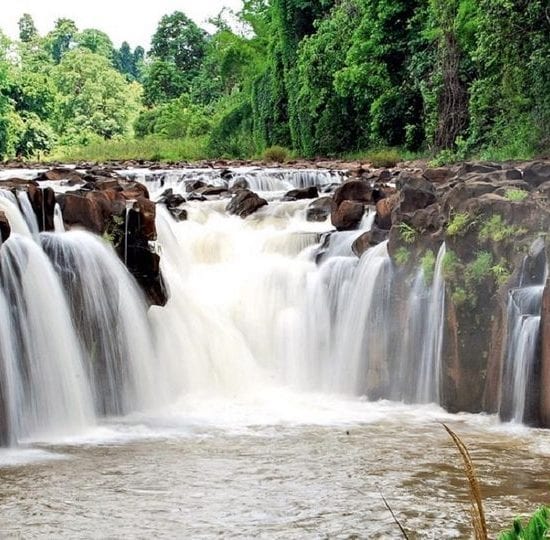Laos incredible
per person
The journey begins from the historically preserved city Luang Prabang, through the mysterious plain of jars, to the wonders of Vat Phu, ruins of the pre-Angkorian civilization.
Luang Prabang – Xieng Khoung – Vientiane – Done Khong Island – Pakse
10 days 09 nights
Travel styles: Classic and cultural
Download PDf
0
Reviews
Tour Plan
1
Day 1 Arrival Luang Prabang
Upon arrival at the airport, transfer to hotel. Luang Prabang is perhaps the best-preserved traditional city in Southeast Asia. After a short rest, visit the impressive stupa of Wat Visoun and the shrine of Wat Aham, Wat Mai. Then climb up to the top of Mount Phousi for a beautiful sunset view of the city and the Mekong River. From there, we explore the Night Market. Overnight in Luang Prabang.
2
Day 2 Luang Prabang – Pak Ou Caves – Luang Prabang (B)
After breakfast, visit the city’s oldest temple Wat Sene and the magnificent Wat Xiengthong. Then board a cruise upstream on the Mekong River to visit the mysterious Pak Ou Caves. En route, stop at the village of Ban Xanghai, where the local specialty of rice wine is produced. Once back in Luang Prabang city we take a short drive to Ban Phanom, a village well known for its hand weaving, also take time to visit Ban Xangkhong, Ban Xienglek, two small villages well known for silk weavings and for Saa (jute) papermaking. Overnight in Luang Prabang.
3
Day 3 Luang Prabang – Khouangsi Waterfalls (B)
An optional early start gives you the fantastic opportunity to participate in the daily morning rituals of saffron-clad monks collecting offerings of Alms (ubiquitous sticky rice) from the faithful residents. This tradition is very unique in Laos, being the only Buddhist nation still preserving the procession. From there you will visit the morning Phosi Market where you will see such diverse offerings as dried buffalo skin, local tea and saltpeter among the chickens, vegetables and hill-tribe weavings. Laos is also known for its traditional handicrafts, and today you will visit local village of Lao ethnic minority groups at Ban Ouay and Ban Thapene. Time permitting you may also wish to drive to the beautiful Khouangsi Waterfall where you can splash around in the turquoise pools or walk along the forest paths. We return to Luang Prabang by late afternoon for observing the sunset at Wat Siphouthabath.
4
Day 4 Luang Prabang – Xiengkhouang (Road) (B)
After breakfast, we visit the National Museum (closed Tuesday) at the former Royal Palace, which displays a lovely collection of artefacts reflecting the richness of Lao culture dating from the days of the early kings right through the last sovereign, and visit the Central Market. Today, we drive 306km uphill a mountain surrounded by wonderful natural scenery to Xiengkhouang, which was devastated by American bombing between 1964 and 1973. Upon arrival, transfer out to visit the Plain of Jars, an impressive archaeological site where hundreds of large stone jars are scattered all over the plateau. If time permits, we see the old capital of Muang Khoun and the nearby villages, home to the Hmong hill tribe people. They have an interesting local culture and a colorful history. Overnight in Xiengkhuang
5
Day 5 Xiengkhouang – Vientiane (Flight) (B)
After breakfast, we visit the Central Market. And you may have free time to explore the town before catching the flight to Vientiane. Check-in hotel. If time permits, visit the impressive Lao-Thai Friendship Bridge and the Buddha Park, a scattered enchanting collection of Buddhist and Hindu sculptures on the Mekong Riverside meadow, close to the Friendship Bridge. There are approximately 200 religious images dating back over 500 years, which were created by a mysterious monk spreading his philosophy on life and revealing his ideas about the universe. A spectacular view of over the Mekong River at sunset is a perfect way to finish the day. Overnight in Vientiane.
6
Day 6 Vientiane – City Tour (B)
After breakfast, we explore Vientiane capital by visiting the major sights of the capital, including the oldest Wat Sisaket with thousands of miniature Buddha statues and the former royal temple of Wat Prakeo, which previously housed the famous Emerald Buddha Image. Enroute to Lao’s national precious heritage, the famous and sacred structure of That Luang Stupa, you will have the opportunity to take some pictures of the imposing Patuxay Monument, which is well known as Vientiane’s own Arc de Triumph.
Afternoon, have a leisure walking to visit Wat Ong Tue, Wat Inpeng and Wat Haisok. We pass by the major shopping area continuing to the Vientiane Central Market of Talad Sao and Talad Kouadin where various goods are displayed for sale. We return to the Mekong Riverside in the late afternoon for observing the sunset. Overnight in Vientiane.
7
Day 7 Vientiane – Pakse – Don Khong Island (Flight) (B)
After breakfast, we catch an early flight to Pakse. On arrival, we drive on the National Road No. 13th South to Champasak and visit the fascinating pre-angkorian ruins of Wat Phu, one of Southeast Asia's most dramatically situated temples. We have time to explore these intriguing Khmer ruins, which are perched at the base of Mount Phu Kao. Wat Phu is one of the Lao World Heritage sites recognized by UNESCO in 2001, this wonderful archeological site of Khmer civilization dates back to the 10th century, predating the famous Angkor Wat in Cambodia. We continue our journey by road to Don Khong, the largest island in the South Mekong river region known as the 4000 islands, one of the most scenic areas in Laos. Overnight in Don Khong Island.
8
Day 8 Don Khong Island – Surrounding (Boat) (B)
After an early breakfast, we explore the local villages of Ban Khone, where you will see an array of relics from the French colonial era and retrace the old colonial past, including old French colonial buildings and the remnants of the first Lao railway with its locomotive. We continue discover the 4000 islands area by boat at our leisure to visit the Liphi waterfall, one of the most beautiful waterfalls marking the end of Lao border to Cambodia, also known as the Samphamith. If we are lucky, we may even see the rare freshwater Irrawaddy Mekong dolphin at Ban Hang Khone. We return to Ban Nakasang and drive to famous waterfalls of Khone Phapeng, the largest waterfall in South East Asia, known as Niagara of the east. Overnight in Don Khong Island.
9
Day 9 Don Khong Island – Tadlo – Pakse (B)
Upon leaving Done Khone Island, we continue our journey towards Tadlo, through Boloven plateau. The Boloven Plateau is known for its cooler temperature being located high above the Mekong Valley. Rivers run off this high plateau in all directions and then plunge out to lush forests along in a series of spectacular surging waterfalls. A trip to the plateau provides a refreshing break from the heat and allows you to observe the cultivation of rich coffee, tea, cardamom, bananas, and other crops that can be seen en route. This trip gives visitors the chance to venture off the beaten track and to discover some of the lesser-known areas of Laos, exploring the wild beauty of this southern region. Upon arrival at Tad Lo waterfall, we visit the villages of Alak, Nge, and Katu, populated by ethnic minority groups. We return to Pakse by late evening. Overnight in Pakse.
10
Day 10 Pakse – Departure (B)
After breakfast, there will be free time for your own exploration of Pakse Town before catching a flight to Siem Reap-Cambodia or exiting Laos overland from the Chongmek International checkpoint to Ubon Rathani Thailand.
Tour cost included:
- Private air-conditioned vehicle
- Local English speaking guide in each city
- Accommodations on Double/Twin share with daily breakfast
- Meals (excluding drinks) as specified
- Sightseeing fee as specified, on a private basis
- Government tax and services charges
- Complimentary drinking water
- Drinks - private expenses
- Travel insurance of all types
- Tips
- All airfares and visa
- All types of bank fees for payment
- Other services not mentioned












